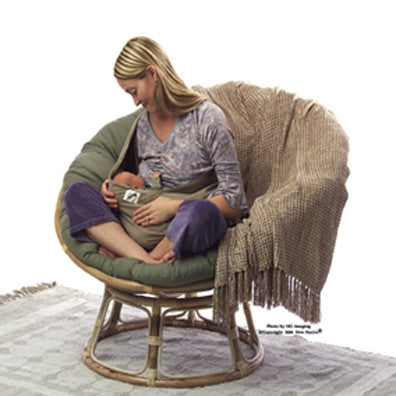8 Reasons Breastfeeding Reduces SIDS

From http://www.askdrsears.com, Download. Website.
Breastmilk: The Milk, The Mother, Or The Method
Whether it is the milk, the mother, or the method that is responsible for the lower SIDS risk in the breastfed infant is hard to tell. It’s probably a combination of all three which proves breastfeeding reduces SIDS.
THE MILK
There are hundreds of substances in human milk that aren’t in artificial milk. These cannot be manufactured or bought; they can only be made by mother. Each year researchers discover new factors in human milk that are beneficial to baby. I suspect that researchers have only scratched the surface of what amazing factors exist in human milk. The following is what we know. What is even more intriguing is what we do not yet know about how human milk benefits human babies in general and how it lowers the risk of SIDS in particular.
1. Breastmilk Fights Against Infection
Respiratory and gastrointestinal infections contribute to the SIDS risk, and breastfeeding infants get fewer respiratory and gastrointestinal infections. Breastfeeding protects against RSV (respiratory syncytial virus) infections, and this virus has been implicated in causing inflammation of the lungs that could contribute to SIDS.
Between two and six months of age (which, you’ll recall, is also the peak period of SIDS risk), a baby’s immunity is lowest and the vulnerability to infection is highest. The newborn baby derives much of his immunity from his mother’s antibodies while in the womb. After birth these antibodies gradually disappear. Meanwhile, baby is making his own antibodies, so that by age six to nine months he is more capable of defending himself against infection. Between two and six months, when the antibodies derived prenatally from mother are at low levels and baby has not yet made enough of his own, the immunity factors in breastmilk fill in, taking over where the placenta left off and protecting the baby while his own immune system matures.
One of the ways in which breastmilk protects the infection-vulnerable infant is through the enteromammary immune system. When mother is exposed to a new germ, glands in her intestine make infection-fighting cells specifically for this germ. These special cells travel through her bloodstream to her breasts, where they announce the presence of the enemy germ. The breast glands respond by manufacturing antibodies, which are delivered to the baby through the milk. Because she can make new antibodies better and more quickly than her tiny baby can, mother updates her baby’s immunity with every feeding. Would it be presumptuous to call breastmilk a SIDS vaccine? Read on.
2. Breastmilk Builds Better Brains
“MOTHER’S MILK: FOOD FOR SMARTER KIDS.” This was the headline in USA Today on February 2, 1992. While both experience and research have long suggested that breastfed babies are intellectually advantaged, the difference has usually been attributed more to the nurturing or to the character of the mother than to the type of milk. But new research suggests that it’s human milk itself rather than (or in addition to) the process of breastfeeding (or the skills of the mother) that enhances brain growth. Brain-building substances and elements called “growth factors” have recently been discovered in human milk. Researchers in England studied three hundred babies who were very premature and weighed less than four pounds, a group that is at high risk for SIDS. They divided their subjects into two groups: those who were fed their mother’s milk and those who were not. Because of their prematurity, these infants received the milk by tube rather than directly from the mother’s breasts, thereby separating the effects of the milk from the effects of the nurturing. Those premature babies who got their mother’s milk during the first five or six weeks of life averaged 8.3 points higher on IQ tests at age seven-and-a-half to eight years. Also significant in this study was that the more breastmilk the babies received, the higher these children scored. Since this study, over eleven more studies have concluded that breastfeeding builds better brains.
Why does human milk build better brains? Special nutrients in human milk that are not in artificial baby milks may be the answer. Human milk contains substances (such as cholesterol, linolenic acid, and taurine) that enhance the development of the central nervous system in several ways, the most convincing of which is that it provides vital fats, namely DHA for myelin, the insulating sheath around nerves that helps impulses travel faster. (Postmortem examinations have shown deficient myelination—the covering around nerves that lets impulses travel faster—in the nerves around the respiratory control center in some infants who died of SIDS). These areas show changes that could be the result of delayed development and/or oxygen deprivation. So vital are these brain builders that if a mother’s milk is short on these special nutrients, the mammary glands themselves make and deposit them into her milk. Although myelination continues well into early childhood, the greatest degree of myelination occurs during the first six months of life.
3. Breastmilk is Kinder to Tiny Airways
Besides reducing respiratory infections that clog baby’s air passages, breastfeeding also helps keep little airways open by not exposing them to the allergens in foreign milk. Stuffy noses and airways and recurrent respiratory-tract infections are frequent signs of allergies to artificial milk made from cow’s milk or bean milk (such as soy). Breastfeeding helps breathing in two ways: by helping the brain systems that control breathing to mature, and by helping to keep tiny air passages open. It is also interesting to note that breastfeeding infants have higher blood levels of the hormone progesterone, and progesterone stimulates breathing. In summary, babies who get breastmilk breath better.
As a final perk, even if human milk goes down the wrong pipe and enters baby’s lungs, it does not irritate the lungs as much as formula can. Human milk is not a foreign substance. Also, studies on experimental animals have shown that the introduction of water or cow’s milk into the upper trachea (the beginning of the airway) can lead to apnea. This did not occur when normal saline (a physiological solution similar to the infant’s own blood) or the species’ own milk was squirted into the trachea. These researchers concluded that aspiration of water or foreign milk may cause a stop-breathing episode in infants, a life-threatening episode that might not occur if mother’s milk accidentally goes down the wrong way.
4. Breastfeeding Reduces Reflux
Gastroesophageal reflux (GER) is less severe in breastfed infants than in infants fed artificial baby milks, probably due to the fact that human milk is emptied faster from the stomach. Since GER has been implicated in apparent life-threatening events (ALTEs) and ALTEs may be a forerunner of SIDS, reducing GER could also reduce SIDS.
5. Breastfeeding Promotes Safer Sleep
6. Breastfeeding organizes baby. I believe that an important piece of the SIDS puzzle is that some babies at risk of SIDS have an overall “disorganized physiology.” Breastfeeding has a calming effect on a baby. The harmony between a breastfeeding mother and her suckling infant has an organizing effect on baby’s sleep/wake cycles, probably as a result of the cue-response sensitivity of the breastfeeding pair.
THE MOTHER
Not only does breastmilk have protective qualities for baby, breastfeeding does good things for mother, which indirectly may reduce the risk of SIDS.
7. Breastfeeding Increases Mother’s Awareness
Breastfeeding is an exercise in babyreading. It increases the sensitivity of a mother to any changes in her baby. The increased maternal hormones (primarily prolactin and oxytocin) that are stimulated by baby’s sucking appear to provide a biological basis for the concept of mother’s intuition. During my 30 years of watching mothers and babies, I have been impressed by the increased sensitivity breastfeeding mothers have toward their babies. They’re able to read subtle cues and changes in their infants. Cindy, a breastfeeding mother, told me: “I can tell when my baby has an ear infection by the way she sucks.” Breastfeeding mothers tend to sleep with their babies, a nighttime parenting style that I believe decreases SIDS risk. A breastfeeding mother also sleeps differently than her formula-feeding friends. She may be more aware of changes in her baby, even while they both are sleeping. (See Co-sleeping and SIDS)
Can formula-feeding mothers attain this high level of sensitivity to their babies? I suspect they can, especially if they practice the rest of the attachment-parenting package, such as sharing sleep and wearing their baby. Yet without the hormonal boost that breastfeeding provides, bottle-feeding mothers have to work harder at developing this heightened awareness.
THE METHOD
Besides the good stuff in breastmilk and the act of breastfeeding itself with its increased “touch time,” the way an infant breastfeeds may also lower the risk of SIDS.
8. Breastmilk Improves Breathing/Swallowing Coordination
Newborns have to learn to coordinate breathing and swallowing during feeding. For premature infants (those at highest risk for SIDS), this is a gradual learning process. Studies show that premature babies who breastfeed coordinate sucking, swallowing, and breathing more efficiently than do their bottlefeeding mates. Breastfeeders also tend to feed more frequently than their bottlefeeding friends, therefore getting more practice coordinating their swallowing and breathing. Since tiny infants tend to have weak points in muscle support of their upper airways, their breathing passages are narrower, especially during sleep. Any exercise of the mouth and throat muscle is helpful in keeping the airways open.
In full-term infants, breastfeeding helps keep tiny airways open by helping the jawbone and muscles of the upper airway develop better. Dental studies show that breastfeeding babies develop better alignment of the oral cavity. Dr. Shirley Tonkin, a New Zealand researcher, told me she believes that breastfeeding infants are more likely to use their jaws and pharyngeal muscles in a sucking motion that enhances the development of muscles, bones and lips—all of which helps keep their airways open better than those of bottlefeeding babies. Dr. Tonkin, a pathologist, speculated that the different muscle actions involved in bottlefeeding may contribute to the growth of larger tongues, thus further narrowing the already unstable airway of tiny infants. A recent postmortem finding that SIDS babies have larger tongues lends support to Tonkin’s theory. The more stable the airway to breathing, the lower the risk of SIDS.
Putting infants to sleep on their backs or sides rather than on their stomachs may lower the risk of SIDS. When my wife, Martha, breastfed our eight babies, she invariably put them to sleep on their backs or sides, believing that in this position the breastfeeding pair had easier access to nursing at night. Breastfeeding mothers I have interviewed, especially those who share a bed with their infant, most often place their babies on their sides facing them; or the infant often sleeps in the crook of mother’s arm, necessitating a back or side position.
As we await the results of more research, we can continue to rely on common sense. The milk of each species of mammal is different and designed to insure the best chances of survival for the young of that species. (Consider what happens if you put the wrong fuel into a car. Sooner or later it doesn’t run right and its engine control systems fail.) I believe that someday a researcher will discover what savvy mothers have long suspected: there are nutrients in mother’s milk that help keep new lives living. In the meantime, it’s possible that any one of the protective effects of breastfeeding could lower the SIDS risk, even slightly. When you put together all the benefits of breastfeeding, the good stuff in breastmilk, the special touch of breastfeeding, and the special actions of breast suckling, you have a compelling case that breastfeeding increases an infant’s chances of health and well-being.



